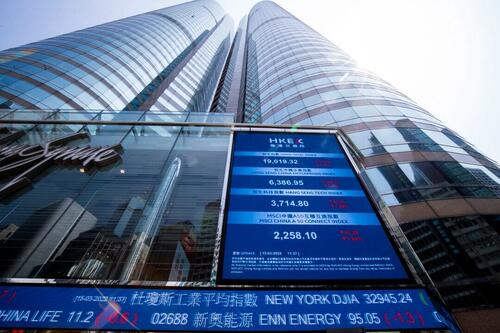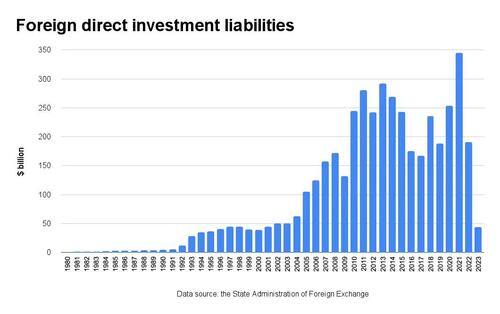
60 More Chinese Stocks To Be Culled From MSCI Indexes
Authored by Lily Zhou via The Epoch Times (emphasis ours),
MSCI Inc. is culling 60 more Chinese stocks from its indexes in its latest quarterly review, the U.S. index provider said on Monday.
 An electronic screen displays (from top) the Hang Seng Index, Hang Seng China Enterprises Index (HSCEI), Hang Seng Tech Index, and MSCI China Index in Hong Kong, on March 15, 2022. (Paul Yeung/Bloomberg via Getty Images)
An electronic screen displays (from top) the Hang Seng Index, Hang Seng China Enterprises Index (HSCEI), Hang Seng Tech Index, and MSCI China Index in Hong Kong, on March 15, 2022. (Paul Yeung/Bloomberg via Getty Images)It’s the third large-scale removal of Chinese stocks from the MSCI Global Standard indexes this year following 66 and 56 deletions announced in February and May, respectively.
Meanwhile, seven Indian stocks have been added to the list, narrowing the gaps between investments in the two countries.
In a list published on Monday, MSCI Inc. said it’s adding two Chinese stocks to its global standard indexes and removing stocks of 60 companies from China and another from Hong Kong.
The two additions are state-owned hydropower firm Huaneng Lancang and circuit board manufacturer Victory Giant.
Those set to be struck off the indexes also include stocks of a number of state-backed firms, such as CSSC Science & Technology Co. Ltd., which manufactures ship parts and steel structures; financial service firm AVIC Industry-finance Holdings; and media companies People.cn and China Film Group Corporation.
The changes will also affect the MSCI All Country World Index and the MSCI Emerging-Markets Index.
Meanwhile, two slightly larger lists of stocks will be removed from the MSCI China-A onshore index and the MSCI China all shares index.
Huaneng Lancang and Victory Giant will both be added to the indexes, while there will be 62 removals from the China all shares index and 69 from the A onshore index.
While China suffered the biggest cull from the latest MSCI indexes review, India was the biggest beneficiary, with seven stocks added and one removed, narrowing the gap between the two countries.
According to Abhilash Pagaria, head of Nuvama Alternative and Quantitative Research, China’s weight on the MSCI index will drop from 24.8 percent to 24.2 percent while India’s weight will climb up to 19.8 percent from 19.2 percent.
In June, MSCI published a blog saying investors had become more cautious about the market and geopolitical risks of investing in China, while China’s outbound investments had continued to grow.
Record Loss in Foreign Investment
According to provisional figures published on Friday by China’s State Administration of Foreign Exchange, foreign investors pulled out a record $14.8 billion during the second quarter of this year.
It was the second season in which foreign investors pulled more money out of China than the amount they put into the economy since seasonal data began in 1998.
The net figure first went into negative in the third quarter of 2023, when $12.1 billion of foreign direct investments were withdrawn.
It was less than two years after China’s net foreign direct investments peaked at $107.2 billion in the first quarter in 2022.
The $14.8 billion loss of foreign direct investments between April and June was partly offset by a $10.2 billion net gain in the first quarter, leaving $4.6 billion of net loss in the first half of this year.
 China’a foreign direct investment liabilities data published by the State Administration of Foreign Exchange. (Graph by The Epoch Times)
China’a foreign direct investment liabilities data published by the State Administration of Foreign Exchange. (Graph by The Epoch Times)It’s the first time the semiannual figure went below zero. If the trend continues into the second half of the year, 2024 will be the first year on record with a net outflow of foreign direct investments.
The outflowing of foreign direct investment in 2024 followed its dramatic drops in the past two years.
According to SAFE statistics, in 2023, China’s annual foreign direct investment liabilities hit $42.7 billion, the lowest since 2000.
It was only 22 percent of the amount in 2022 and one-eighth (12.4 percent) of net foreign direct investment in 2021, when the figure peaked at $344.1 billion.
Travis
Thu, 08/15/2024 – 07:20















![Odpowiedzą za zniszczenie mienia i znęcanie się nad zwierzętami. Policja ustaliła sprawców [VIDEO]](https://www.infoprzasnysz.com/wp-content/uploads/2025/01/myl-konia-myjka.jpeg)

